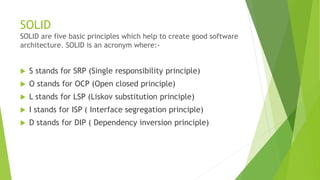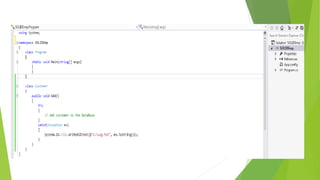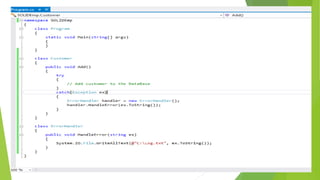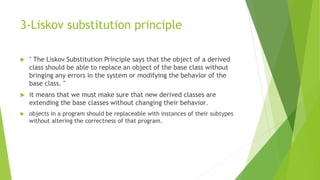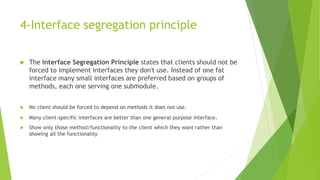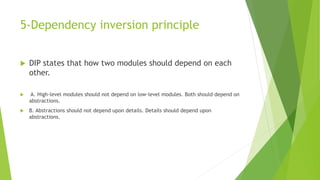Solid Principles
- 1. SOLID PRINCIPLES Presented By : Gaurav Mishra
- 2. SOLID SOLID are five basic principles which help to create good software architecture. SOLID is an acronym where:- ïĩ S stands for SRP (Single responsibility principle) ïĩ O stands for OCP (Open closed principle) ïĩ L stands for LSP (Liskov substitution principle) ïĩ I stands for ISP ( Interface segregation principle) ïĩ D stands for DIP ( Dependency inversion principle)
- 3. 1 - Single responsibility principle SRP says that a class should have only one responsibility and not multiple.
- 6. 2-Open closed principle ïĩ Open/Closed principle says that a class should be open for extension but closed for modification. Which means that you can add new features through inheritance but should not change the existing classes.
- 9. 3-Liskov substitution principle ïĩ " The Liskov Substitution Principle says that the object of a derived class should be able to replace an object of the base class without bringing any errors in the system or modifying the behavior of the base class. " ïĩ it means that we must make sure that new derived classes are extending the base classes without changing their behavior. ïĩ objects in a program should be replaceable with instances of their subtypes without altering the correctness of that program.
- 13. 4-Interface segregation principle ïĩ The Interface Segregation Principle states that clients should not be forced to implement interfaces they don't use. Instead of one fat interface many small interfaces are preferred based on groups of methods, each one serving one submodule. ïĩ No client should be forced to depend on methods it does not use. ïĩ Many client-specific interfaces are better than one general-purpose interface. ïĩ Show only those method/functionality to the client which they want rather than showing all the functionality
- 16. 5-Dependency inversion principle ïĩ DIP states that how two modules should depend on each other. ïĩ A. High-level modules should not depend on low-level modules. Both should depend on abstractions. ïĩ B. Abstractions should not depend upon details. Details should depend upon abstractions.


